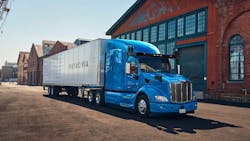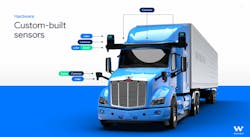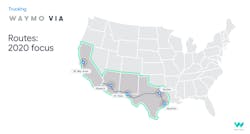Waymo provided an updated overview of how their self-driving technology fits into the trucking landscape and the challenges they face getting that tech to fleets during a June 30 virtual roundtable.
Since 2017, Waymo Via, the company’s business that focuses on trucking and local delivery, has been testing its Waymo Driver technology — comprising an array of sensors and cameras, and the algorithms that direct the truck — in California, the Southwest and Georgia. Waymo employs Peterbilt 579 Class 8 trucks and Chrysler Pacifica minivans. The system can “see” three football fields away using cameras, radar and Light Detection and Ranging (LIDAR) technology and calculate where the pieces on the asphalt chess board will be at all times as to not collide with them.
It’s impossible to predict exactly when autonomous trucks will hit the open road and where they will make financial sense, but the Alphabet-owned Waymo thinks the potential benefits are worth exploring.
They’ve convinced several investors outside of Mountain View, Calif., as Waymo announced it has raised $3 billion in its first external fundraising round (which is for both consumer and commercial ventures). Competing self-driving truck startups Plus.ai and TuSimple are also attracting hundreds of millions of investment capital. TuSimple also just announced the creation of the world's first Autonomous Freight Network, which will combine autonomous trucks, digital mapped routes, strategically placed terminals, and TuSimple’s autonomous operations monitoring system. Partners for that project include McLane, Penske, UPS and U.S. Xpress.
But why is so much money being poured into robot trucking? It makes sense to automate factories with industrial robots, where the job is all about repetition or limited in speed and strength. But truck drivers are faced with a dozens of scenarios an hour where they must use their analytical brain to recognize danger, like an accident on the shoulder, and react appropriately—by slowing down and changing lanes.
Safety, though, is the main reason to grow the tech, Waymo said. They seek to reduce the number of accidents involving large trucks, which attributed to 4,000 deaths in 2018. The number of such fatalities spiked more than 30% from 2009.
“Fatalities from large truck crashes have been increasing over the decade, while the overall crash fatalities have decreased during that period,” said Vijaysai Patnaik, Waymo Via trucking product lead. “So our goal really is to improve the safety on the road by making every mile traveled with Waymo Driver safer, because it doesn't get tired or distracted.”
Patnaik pointed out that Over the Road drivers can spend on average four to six weeks away from home per trip. According to the Federal Motor Carrier Safety Administration regulations on hours of service, these drivers can only drive 11 hours per 24-hour cycle.
He also said due to an average 50% asset utilization and three-hour dwell times, inserting self-driving tech could improve efficiency.
“We believe our technology can help minimize this fleet downtime and have a positive effect on the company's reputations and insurance costs, as well as helping ensure that the shipments arrive safely, securely and on time to where they need to go,” Patnaik said.
The first pilot program began in 2018 at Google’s data center in Atlanta, a busy logistics hub that could challenge the tech. Last year Waymo added 13 engineers from Anki, a consumer robot startup that could never find its footing, to spearhead the trucking initiative.
Via has the advantage of leveraging Waymo’s more than 10 years of experience and technological development, as well as Alphabet’s cloud and machine learning infrastructure.
“The fact that we've gone through so many iterations on the car side means we can move much more quickly and aggressively on the trucking side,” said Boris Sofman, Waymo Via trucking engineering lead and former CEO of Anki.
“We have roughly two times the sensors as a car does,” Sofman explained. “A lot of this is to handle the really unique shape of a truck and inclusions that a trailer causes.”
“There's a lot more emphasis on long range perception because we're driving with a large vehicle at larger speeds on a freeway and have a longer stopping distance,” Sofman continued. “So that led us to really push our perception range far beyond 300 meters in order to be able to adapt to this environment and feel comfortable in handling any situation that might come up.”
Truckers should not be running to the nearest coding bootcamp just yet, though. Sofman said the rest of the decade will be used to uncover more engineering best practices, validate the systems and instill confidence that the solution is reliable and safe.
That is no small task.
“Given the fact that we could have 80,000 pound trucks driving 65 miles an hour, we need to be able to handle the very rare but very important long tail challenges—things like construction zones that could come up anywhere and various types of mechanical or other hardware or software failures,” Sofman said.
So far, Waymo has logged 15 billion miles in simulations and 20 million miles on public roads.
“There's a lot of scenarios that you just simply will never be able to predict or iron out in simulation purely,” Sofman said. “So physical miles we feel is a really critical part of validating the quality of our systems.”
A 91-acre “mock city” in Central California offers Waymo a sandbox to test several conceivable road scenarios, from suburban roads to highways to railroad crossings.
This year, Waymo Via partnered with UPS to deliver packages. The emphasis is on point-to-point and transfer hub deliveries, with routes going through the Bay Area and along the Southwest Corridor from Houston to the Arizona-California border.
The long-term vision includes working with OEMs and Tier-1 suppliers to integrate the tech and ultimately fleets to implement it.
“While we continue to test our driver in plastic trucks to scale up pilots and initial deployments over the coming years, we'll operate on our own fleet of trucks,” said Charlie Jatt, Waymo trucking commercial lead. “We'll offer with that fleet of trucks freight services to our eventual fleet customers deeply integrated in their fleet operations to make that as smooth of a transition as possible.”
If and when self-driving tech does make it to typical fleets, the technology does have the potential to not only improve safety, but lower associated costs across the trucking industry.
“Nuclear verdicts are definitely a big deal and something we hear from [our] partners more in discussions with, and that translates to insurance premiums in the industry are skyrocketing,” Jatt said. “More than anything, it serves as a validation for us of just how invaluable the safety case of the technology we're building really can be in the long term.”







